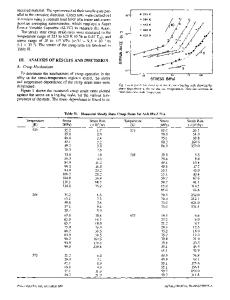A13-Type phase revealed in rapidly solidified high-carbon iron alloy
- PDF / 1,122,904 Bytes
- 3 Pages / 597.6 x 774 pts Page_size
- 66 Downloads / 313 Views
and E. TANAKA Iron-based alloys, when rapidly solidified, can contain phases, such as austenite, E phase, X phase, amorphous phase, etc. The E phase, which is reported by Ruhl and Cohen, II] has a hexagonal close-packed structure and contains a large amount of carbon in solution. The X phase, as well as the E phase, is a nonequilibrium phase and has a cubic structure. [2.3.4] The authors[5] showed that the Cr-Mo iron alloy with a rather high carbon content of 4.4 pct exhibits the amorphous phase. Thus, rapidly solidified iron alloys reveal many different phases. In the present work, we report that an unknown phase was revealed in a Cr-Mo iron alloy with a lower level of carbon than that reported previously. [5] H. ERA, Associate Professor, and K. KISHITAKE, Professor, are with the Department of Materials Science and Technology, Kyushu Institute of Technology, Tobata, Kita-Kyushu, Japan. F. OTSUBO, formerly Graduate Student, Kyushu Institute of Technology, is with Sumitomo Metal Ind. Ltd., Osaka, Japan. E. TANAKA, Technical Assistant, is with the High Voltage Electron Microscope Research Laboratory, Kyushu University, Fukuoka, Japan. Manuscript submitted June 8, 1990.
A high-carbon iron alloy contammg chromium and molybdenum was rapidly solidified by means of a single roller method. The rapidly solidified ribbon had a chemical composition of 2.7 wt pct C, 0.9 wt pct Si, 9.8 wt pct Cr, and 10.0 wt pct Mo. The peripheral speed of the roller was 34 mis, bringing about a high cooling rate of 5 ]04 to 10 K/s. The ribbon thickness was about 80 J,tm. Figure 1 shows scanning electron micrographs of the rapidly solidified ribbon. A region near the bottom surface, i.e., the roller side, reveals an equiaxed grain structure. On the other hand, an upper region near the top surface exhibits a dendrite structure. Figure 2 shows transmission electron micrographs of the upper region. Dendrite morphology is seen, and the dendrite is confirmed by the diffraction pattern to be austenite phase. The small spots in the diffraction pattern may be due to carbides surrounding the austenite dendrite. Figure 3 shows transmission electron micrographs of the region near the bottom surface. The diffraction patterns were obtained by tilting the specimen in the electron microscope. They show four-, two-, and threefold patterns. The symmetry of the patterns makes clear that the phase has a cubic structure with a lattice parameter of 0.63 nm. Analytical transmission electron microscopy showed that the austenite phase contained 8 ± 1 pct Cr and 7 ± 1 pct Mo, while the carbide region contained 12 ± 1 pct Cr and 14 ± 1 pct Mo. It is suggested that the austenite solidifies, rejecting the elements, and then carbide crystallizes from the enriched liquid. The cubic phase possessed 10 ± 1 pct Cr and 10 ± 1 pct Mo. The carbon
Q)
U
o
~
L;:) C/)
(]) Q) L~
Q)
'U C/)
o
L
Fig. I-Scanning electron micrographs (longitudinal scction): (a) low magnification and (b) and (e) high magnification. METALLURGICAL TRANSACTIONS A
VOLUME 22A. JANUARY 1991-251
( a
Data Loading...











